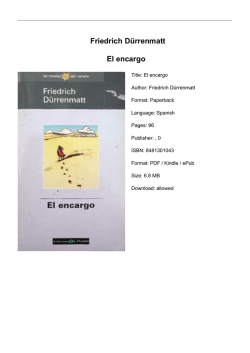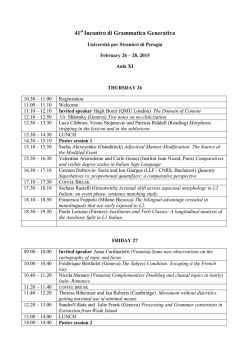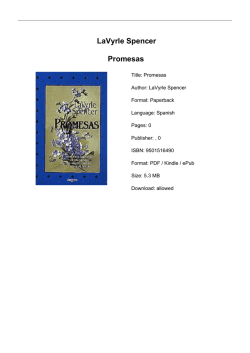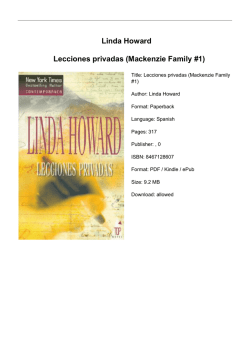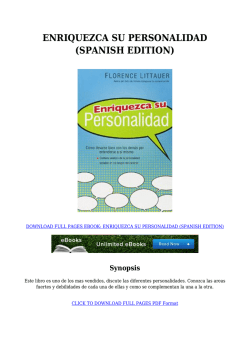
Problematic Cases in the Annotation of Negation in Spanish
Problematic Cases in the Annotation of Negation in Spanish
Salud Marı́a Jiménez-Zafra1 , M. Teresa Martı́n-Valdivia1 , L. Alfonso Ureña-López1 ,
M. Antònia Martı́2 , Mariona Taulé2
1
Department of Computer Science, Universidad de Jaén,
Campus Las Lagunillas, E-23071, Jaén, Spain
{sjzafra, maite, laurena}@ujaen.es
2
CLiC, Centre de Llenguatge i Computació, Department of Linguistics,
University of Barcelona, 08007, Barcelona, Spain
{amarti, mtaule}@ub.edu
Abstract
This paper presents the main sources of disagreement found during the annotation of the Spanish
SFU Review Corpus with negation (SFU ReviewSP -NEG). Negation detection is a challenge in
most of the task related to NLP, so the availability of corpora annotated with this phenomenon
is essential in order to advance in tasks related to this area. A thorough analysis of the problems
found during the annotation could help in the study of this phenomenon.
1
Introduction
Negation is a key element in tasks related to Natural Language Processing (NLP) that has generated
special interest in the research community during the last years, such as Sentiment Analysis, Information Extraction and Question Answering. It is a complex linguistic phenomenon that requires a deep
analysis. The availability of corpora annotated with negation is essential for carrying out a study of this
phenomenon. Actually, most of the available corpora are for English language (Pyysalo et al., 2007; Kim
et al., 2008; Vincze et al., 2008; Councill et al., 2010; Konstantinova et al., 2012; Morante and Daelemans, 2012; Bokharaeian et al., 2014; Blanco and Moldovan, 2014; Banjade and Rus, 2016). However,
the presence of languages other than English on the Internet is greater every day and, consequently, the
development of systems able to deal with negation in these other languages is a necessity. Due to this
fact, we decided to annotate a Spanish corpus with negation. Moreover, taking into account the importance of negation in texts that express opinions since it directly affects their polarity, we also annotated
how negation affects the polarity of the words that are within its scope.
The Spanish SFU Review Corpus (Taboada et al., 2006) was selected for the annotation because of
its multi-domain nature and the fact that it is widely known in the domain of Sentiment Analysis and
Opinion Mining. The English version of the SFU Review Corpus was annotated at the token level with
negative and speculative keywords and at the sentence level with their linguistic scope (Konstantinova
et al., 2012). The authors used the guidelines defined by Vincze (2010), but they adapted the annotation
scheme to the review domain (Konstantinova and De Sousa, 2011). Although we considered these
guidelines, after a thorough analysis of negation in Spanish, we defined criteria more suitable to the
typology of negation patterns in this language (Martı́ et al., 2016).
In this work, we show the main problems found during the annotation of negation for the Spanish SFU
Review Corpus (SFU ReviewSP -NEG). The annotation scheme defined is briefly described in Section 2.
Following, the main sources of disagreement are presented in Section 3. Finally, conclusion and future
works are outlined in Section 4.
2 Annotation scheme
The SFU ReviewSP -NEG corpus1 consists of 400 reviews of cars, hotels, washing machines, books,
cell phones, music, computers and movies extracted from the Ciao.es website. Each domain contains
25 positive and 25 negative reviews. We annotated each review at token level with the lemma and the
This work is licensed under a Creative Commons Attribution 4.0 International Licence.
http://creativecommons.org/licenses/by/4.0/
1
http://sinai.ujaen.es/sfu-review-sp-neg-2/
Licence details:
42
Proceedings of the Workshop on Extra-Propositional Aspects of Meaning in Computational Linguistics,
pages 42–48, Osaka, Japan, December 12 2016.
PoS and at sentence level with negation markers or negation cues, their linguistic scope and the event.
We also annotated how negation affects the words that are within its scope (if there is a change in the
polarity or an increment or reduction of its value), which is very useful for Sentiment Analysis. The
general annotation scheme followed can be seen in Figure 1.
Figure 1: General annotation scheme.
The labels used for the annotation of negation in the corpus are described briefly below:
• <review polarity=“positive/negative”>. The attribute polarity describes the polarity of the review, which can be “positive” or “negative”, according to the value assigned to it in the Spanish
SFU Review Corpus.
• <sentence complex=“yes/no”>. The label sentence corresponds to a complete sentence, a phrase
or a fragment/chunk of a sentence in which a negative structure can occur. In SFU ReviewSP -NEG,
we only annotate the structures that contain at least one negation marker or negation cue. Therefore,
sentences without negation markers are not labeled. This label has the attribute complex assigned
to it and it can take one of the following values:
– “yes”, if the sentence contains more than one negative structure <neg structure> (1a).
1a. <sentence complex=“yes”> Sin embargo, <neg structure> las habitaciones no
están cuidadas </neg structure>,hay manchas de humedad, techos desconchados,
<neg structure> las TV no tienen mando a distancia </neg structure>, los suelos de
los pasillos están levantados, necesita una remodelación urgente! </sentence>
‘However, the rooms are not well maintained, there are humidity stains, peeling ceilings,
there is no TV remote control, the floors of the halls are raised, it needs urgent renovation!’
– “no”, if the sentence contains only one negative structure (2a).
2a. <sentence complex=“no”> <neg structure> No hay en la habitación ni una triste hoja
para ver qué hay para comer </neg structure> </sentence>
43
‘The room does not have nor a sad sheet to see what’s for lunch.’
• <neg structure>. This label corresponds to a syntactic structure in which a negation marker or
a negation cue occurs. It has 4 attributes assigned to it, and two of which (change and polarity modifier) are mutually exclusive (1b, 2b):
– polarity: indicates the semantic orientation of the negative structure, i.e., whether it is “positive”, “negative” or “neutral”.
– change: states whether the polarity or the meaning of the negative structure has been totally
modified (change=“yes”) or not (change=“no”) because of the negation.
– polarity modifier: indicates whether the negative structure contains an element that nuances
its polarity. If there is an increment in the intensity of the polarity value it takes the value
“increment” and, in contrast, if there is a diminishing of the polarity value it takes the value
“reduction”.
– value: shows the meaning of the negative structure, that is to say, if it expresses negation
(“neg”); if it indicates contrast or opposition between terms (“contrast”); if it expresses a
comparison or inequality between terms (“comp”) or if it does not negate (“noneg”) despite
containing a negation marker o cue.
1b. <sentencecomplex=“yes”> Sin embargo, <neg structure polarity=“negative”
change=“yes” value=“neg”> las habitaciones no están cuidadas </neg structure>,
hay manchas de humedad, techos desconchados, <neg structure polarity=“negative”
change=“yes” value=“neg”> las TV no tienen mando a distancia </neg structure>, los
suelos de los pasillos están levantados, necesita una remodelación urgente! </sentence>
‘However, the rooms are not well maintained, there are humidity stains, peeling ceilings,
there is no TV remote control, the floors of the halls are raised, it needs urgent renovation!’
2b. <sentence
complex=“no”>
<neg structure
polarity=“negative”
polarity modifier=“increment” value=“neg”> No hay en la habitación ni una triste
hoja para ver qué hay para comer </neg structure> </sentence>
‘The room does not have nor a sad sheet to see what’s for lunch.’
• <scope>. The label scope delimits the part of the negative structure that is within the scope of negation (1c, 2c). It includes both the negation marker or cue (<negexp>) and the event (<event>).
• <negexp>. This label corresponds to the word(s) that express(es) negation (1c, 2c). It can have the
attribute discid associated to it if negation is expressed by more than one negative element and they
are discontinuous (2c).
• <event>. The label event denotes the words that are directly affected by negation (usually verbs or
adjectives) (1c, 2c). It is usually part of the scope, though it can also match the scope.
1c. <sentencecomplex=“yes”> Sin embargo, <neg structure polarity=“negative” change=“yes”
value=“neg”> <scope> las habitaciones <negexp> no </negexp> <event> están
cuidadas </event> </scope> </neg structure>, hay manchas de humedad, techos desconchados, <neg structure polarity=“negative” change=“yes” value=“neg”> <scope> las
TV <negexp> no </negexp> <event> tienen </event> mando a distancia </scope>
</neg structure>, los suelos de los pasillos están levantados, necesita una remodelación
urgente! </sentence>
‘However, the rooms are not well maintained, there are humidity stains, peeling ceilings, there
is no TV remote control, the floors of the halls are raised, it needs urgent renovation!’
44
2c. <sentence
complex=“no”>
<neg structure
polarity=“negative”
polarity modifier=“increment” value=“neg”> <scope> <negexp discid=“1n”> No </negexp>
<event> hay </event> en la habitación <negexp discid=“1c”> ni </negexp> una triste
hoja </scope> para ver qué hay para comer </neg structure> </sentence>
‘The room does not have nor a sad sheet to see what’s for lunch.’
3
Problematic cases
Two types of annotations problems should be distinguished concerning negation: a) those that are related
to the lack of agreement between the annotators, since what it is being annotated is complex: especially
the scope, but also the event, and the discontinuities; and b) the problems arising from how the negation
pattern is interpreted. These cases occur in constructions that are at the limit of what can be considered
negation. They are semantic problems, i.e., problems involved in interpreting these constructions. In our
typology, these cases mainly correspond to negation patterns in comparative and contrastive constructions.
3.1 Disagreement cases
The corpus was annotated by 4 annotators: two trained annotators who carried out the annotation task and
two senior researchers with experience in corpus annotation who supervised the whole process. Firstly,
a training phase was carried out in which 50 files were annotated in parallel by the trained annotators
in order to refine the annotation guidelines. After that, a further 50 files were annotated individually
by the same annotators to measure inter-annotator agreement with the aim of detecting and resolving
problematic cases. A total of 528 negative structures were annotated and 49 cases of disagreement were
found. An observed agreement of 90.72% corresponding to a kappa-score of 0.74 was observed in the
inter-annotator agreement test. We then proceeded to annotate the whole corpus. We will now discuss
the main sources of disagreement (Table 1).
Type of disagreement
<scope> boundary
<event> boundary
<neg structure> extension
Discontinuous elements
Disagreements (total)
#Total
% diagreement in 528
<neg structure>
% disagreement of 49
disagreement elements
16
15
10
8
49
3.03%
2.84%
1.89%
1.51%
9.28%
32.65%
30.61%
20.40%
16.32%
Table 1: Disagreements cases.
Most of the problematic cases (63.26%) were related to the scope of the negation and the event, though
disagreements related to the value of the attributes of the <neg structure> label and to discontinuities
were also observed. Below, we describe these cases with a representative example2 :
• Disagreements related to the scope of negation: 16 disagreements were due to the non-inclusion of
the relative pronoun within the scope (3). We decided to include the relative pronoun (the subject of
the relative clause) in the scope, therefore in the SFU ReviewSP -NEG corpus the subject is always
included within the scope when the word directly affected by negation is the verb of the sentence
(3b):
3. (a) Una cámara de fotos que <scope> no es una maravilla </scope>
(b) Una cámara de fotos <scope> que no es una maravilla </scope>
‘A photo camera that is not so fantastic.’
2
For all cases, the annotation used in the second example (labeled with letter b) was selected. Disagreements were discussed
by all the annotators and solutions were proposed by the senior researchers.
45
• Disagreements related to the event were mainly due to the treatment of verbal forms: pronominal
verbs and light verbs. We observed a total of 15 cases. The problem with the pronominal verbs was
the non-inclusion of the pronoun inside the event (4). In this case, we opted to include the pronoun
inside the event (4b), since it is part of the verb:
4. (a) <negexp> No </negexp> <event> he podido resistir </event> me
(b) <negexp> No </negexp> <event> he podido resistir me </event>
‘I could not resist myself.’
On the other hand, the problem with the light verbs arose from the incorrect identification of the
lexicalized arguments. In (5) the argument una rallada (‘a scratch’) was incorrectly treated as a
lexicalized form, whereas in (6) the opposite is the case: tan mal is part of the verbal form (the
complete verbal form should be: dejar (tan) mal).
5. (a) <negexp discid=“1n”> No </negexp> <event> tenı́a
<negexp discid=“1c”> ni </negexp> una rallada </event>
(b) <negexp discid=“1n”> No </negexp> <event> tenı́a </event>
<negexp discid=“1c”> ni </negexp> una rallada
‘It did not have a single scratch.’
6. (a) <negexp> No </negexp> lo <event> dejaré </event> tan mal
(b) <negexp discid=“1n”> No </negexp> lo <event> dejaré
<negexp discid=“1c”> tan </negexp> mal </event>
‘I will not leave him so badly.’
• 10 disagreements were found in the value of the attributes of the <neg structure> label. Most of
them were related to the value of the attributes polarity and value. For instance, in (7) the negation
structure was annotated as if it expressed negation (value=“neg”), whereas the correct value should
be “contrast”. In (8), the annotator forgot to assign the value of the attribute value to the negative
structure.
7. (a) Los motorolas a mı́ <neg structure value= “neg”
polarity=“negative”> no hacen más que darme problemas <neg structure>
(b) Los motorolas a mı́ <neg structure value= “contrast”
polarity=“negative”> no hacen más que darme problemas <neg structure>
‘Motorolas (devices) have not given me anything but trouble.’
8. (a) <neg structure value=> no me puedo mover <neg structure>
(b) <neg structure value=“neg”> no me puedo mover <neg structure>
‘I can not move (about).’
• Disagreements related to discontinuities were due to the non-identification of intensifiers (9) and diminishers (10). In both of the following examples, the annotator failed to identify the discontinuous
negative expression, the intensifier para nada (‘at all’) and the diminisher del todo (‘completely’)
were not annotated.
9. (a) <negexp> no </negexp> me <event> extraña< /event> para nada los problemas que
tiene
(b) <negexp discid=“1n”> no </negexp> me <event> extraña< /event> <negexp
discid=“1c”> para nada </negexp> los problemas que tiene
‘I am not surprised at all by the problems he is having.’
46
10. (a) <negexp> no </negexp> <event> estaba del todo acertado < /event>
(b) <negexp discid=“1n”> no </negexp> <event> estaba
<negexp discid=“1c”> del todo </negexp> acertado < /event>
‘It was not completely right.’
3.2 Semantic interpretation of negation patterns
In this section we present the cases that generated the greatest controversy during the annotation process.
They are borderline cases in which it is difficult to determine whether negation patterns express negation
or not. These cases are related to comparative constructions (3.2.1) and contrastive constructions (3.2.2):
3.2.1 Comparative constructions
In the case of comparative constructions, the negation simply places an entity below or above another
entity on a scale. What is negated is the predicate expressing somebody’s beliefs. In sample (11), what is
negated is the predicate imaginaba (‘imaginated’). In this type of constructions we decided that there is
no negation, strictly speaking, and we annotated them with the value ‘comp’ for ‘comparative’. Example
(11) can be paraphrased as Me lo imaginaba más grande (‘I imagined it bigger’) or Es más pequeño de
lo que me imaginaba (‘It is smaller than I imagined’). In both cases no negation is present.
11. No es tan grande como me lo imaginaba.
‘It is not as big as I imagined.’
Many of these cases are examples of what is called ‘downward entailment operators’, which are controversial and closely related to negation, but are not featured in this version of the corpus.
3.2.2 Contrastive constructions
Contrastive constructions are used to counterpoise different assessments, either to make a correction (12)
or to add new information (13). In other cases, they can express obligation (14). We agreed to annotate
these structures with the value ‘contrast’.
12. No vinieron 2 soldados, sino 6.
‘Six soldiers came, not two.’
13. No solo lleva rueda de recambio sino también caja de herramientas.
‘It not only has a spare tire but also a toolbox.’
14. No hay más solución que comprar una lavadora.
‘There is no other solution than to buy a washing machine.’
Example (12) declares/states that six soldiers came and the negation refers to a supposed information
about the number of soldiers who came. The function of the negation is to contrast the belief with what
really happened.
Example (13) is a very common coordination construction: no solo... sino también (‘not only... but
also’). The sentence can be paraphrased as Lleva rueda de recambio y caja de herramientas (‘It has spare
tire and toolbox’).
Finally, example (14) is another case of a pattern that is used to reinforce what is said. The sentence
can be paraphrased as an affirmative one La única solución es comprar una lavadora (‘The only solution
is to buy a washing machine’).
4
Conclusions and further work
In this work we have presented the main sources of disagreement detected during the annotation with
negation of the Spanish SFU Review Corpus. We hope this will help in future annotations of this phenomenon. We have also briefly presented the annotation scheme that we defined for the annotation. We
47
think that the availability of corpora annotated at this level is essential for developing systems that take
into account negation; consequently, a thorough analysis of this phenomenon is needed.
Our future lines of research are related to using the corpus to develop a system to generate a model that
uses the information annotated in it in order to automatically detect negation and its scope. Furthermore,
we aim to create a lexicon of simple and complex negation markers. On the other hand, we also intend
to demonstrate the importance of a corpus annotated with negation for Sentiment Analysis.
Acknowledgements
This work has been partially supported by a Grant from the Ministerio de Educación, Cultura y Deporte
(MECD - scholarship FPU014/00983), Fondo Europeo de Desarrollo Regional (FEDER) and REDES
project (TIN2015-65136-C2-1-R) from the Ministerio de Economı́a y Competitividad. We would like to
thank Maite Taboada and her team for sharing the useful SFU resource with the research community.
References
Rajendra Banjade and Vasile Rus. 2016. Dt-neg: Tutorial dialogues annotated for negation scope and focus in
context. In Nicoletta Calzolari (Conference Chair), Khalid Choukri, Thierry Declerck, Sara Goggi, Marko
Grobelnik, Bente Maegaard, Joseph Mariani, Helene Mazo, Asuncion Moreno, Jan Odijk, and Stelios Piperidis,
editors, Proceedings of the Tenth International Conference on Language Resources and Evaluation (LREC
2016), Paris, France, may. European Language Resources Association (ELRA).
Eduardo Blanco and Dan Moldovan. 2014. Retrieving implicit positive meaning from negated statements. Natural
Language Engineering, 20(04):501–535.
Behrouz Bokharaeian, Alberto Diaz, Mariana Neves, and Virginia Francisco. 2014. Exploring negation annotations in the drugddi corpus. In Fourth Workshop on Building and Evaluating Resources for Health and Biomedical Text Processing (BIOTxtM 2014). Citeseer.
Isaac G Councill, Ryan McDonald, and Leonid Velikovich. 2010. What’s great and what’s not: learning to
classify the scope of negation for improved sentiment analysis. In Proceedings of the workshop on negation
and speculation in natural language processing, pages 51–59. Association for Computational Linguistics.
Jin-Dong Kim, Tomoko Ohta, and Jun’ichi Tsujii. 2008. Corpus annotation for mining biomedical events from
literature. BMC bioinformatics, 9(1):1.
Natalia Konstantinova and Sheila CM De Sousa. 2011. Annotating negation and speculation: the case of the
review domain. In RANLP Student Research Workshop, pages 139–144.
Natalia Konstantinova, Sheila CM De Sousa, Noa P Cruz Dı́az, Manuel J Maña López, Maite Taboada, and Ruslan
Mitkov. 2012. A review corpus annotated for negation, speculation and their scope. In LREC, pages 3190–
3195.
M Antónia Martı́, M Teresa Martı́n-Valdivia, Mariona Taulé, Salud Marı́a Jiménez-Zafra, Montserrat Nofre, and
Laia Marsó. 2016. La negación en español: análisis y tipologı́a de patrones de negación. Procesamiento del
Lenguaje Natural, 57:41–48.
Roser Morante and Walter Daelemans. 2012. Conandoyle-neg: Annotation of negation in conan doyle stories. In
Proceedings of the Eighth International Conference on Language Resources and Evaluation, Istanbul. Citeseer.
Sampo Pyysalo, Filip Ginter, Juho Heimonen, Jari Björne, Jorma Boberg, Jouni Järvinen, and Tapio Salakoski.
2007. Bioinfer: a corpus for information extraction in the biomedical domain. BMC bioinformatics, 8(1):1.
Maite Taboada, Caroline Anthony, and Kimberly Voll. 2006. Methods for creating semantic orientation dictionaries. In Proceedings of the 5th Conference on Language Resources and Evaluation (LREC’06), pages 427–432.
Veronika Vincze, György Szarvas, Richárd Farkas, György Móra, and János Csirik. 2008. The bioscope corpus:
biomedical texts annotated for uncertainty, negation and their scopes. BMC bioinformatics, 9(11):1.
Veronika Vincze. 2010. Speculation and negation annotation in natural language texts: what the case of bioscope might (not) reveal. In Proceedings of the Workshop on Negation and Speculation in Natural Language
Processing, pages 28–31. Association for Computational Linguistics.
48
© Copyright 2026
